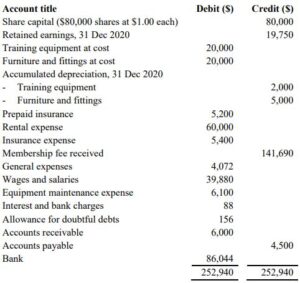| ACC202: Financial and Managerial Accounting |
Question 1
Virtual Yoga is a company started by Arun on 1 January 2020 during the COVID pandemic. It conducts various live stream courses on yoga. Its revenue is derived from fees paid by students on a quarterly or semi-annual basis. It also conducts classes for employees of companies.
Recently, its accountant has contracted COVID and was hospitalized. You are being asked to help to finalize drawing up the Trial Balance as of 31 December 2021.

The following additional information all of which is considered material and (unless stated otherwise) none of which have been taken into consideration in arriving at the figures shown in the trial balance above is listed below:
- On 1 October 2021, Arun sold training equipment costing $1,600, with accumulated depreciation of $150 as at 31 Dec 2020 for cash of $600. Arun deposited the cash into his personal bank account. Arun has also forgotten to inform his accountant of this transaction.
- Both the cost and the accumulated depreciation of the training equipment sold were included in the amount shown for training equipment at cost and the accumulated depreciation for training equipment in the unadjusted trial balance above. The residual value of the training equipment was originally estimated to be $100.
The prepaid insurance relates to the 12-month insurance paid in advance. As at 31 Dec 2021, three months have expired.
- As at 31 Dec 2021, the salaries payable to employees were $$1,200.
- No depreciation has been charged for the year ended 31 Dec 2021. During the
year, no additional non-current assets were purchased. The company depreciates non-current assets held at 31 Dec 2021 as follows: - Training equipment at cost – straight line over five years. The residual value of the training equipment held on 1 January 2021 was estimated to be $2,000.
- Furniture and fittings – declining-balance depreciation method assuming a useful life of four years.
- On 31 December, the number of membership fees paid in advance by private members and corporate members was $$5,125. However, these have been included in membership fees received in the unadjusted Trial Balance.
- It was estimated that 5% of outstanding accounts receivable on 31 December were uncollectible.
- The bank statement received from its banker, the Public Bank Corporation, reveals that the bank service charge of $100 for December was also not recorded by the company.
Required:
(a) Analyse the above information and prepare all necessary adjusting entries. Show narrations and all workings.
(b) Present the following after taking into consideration all the adjustments in (a):
(i) The net profit for the year ending 31 December 2021.
(ii) The total assets as at 31 December 2021.
(iii) The total liabilities as at 31 December 2021.
(iv) The total equity as at 31 December 2021.
Question 2
You have just joined an investment company. Ronald, the CEO of the investment company, has asked you to take a closer look at Sheng Siong Group Ltd, the third-largest supermarket operator. It was reported by The Business Times on 26 January 2021 that “Sheng Siong [employees are] to get up to 16 months’ bonus after strong earnings amid COVID-19 pandemic”.
He asked you to appraise whether Sheng Siong is a good investment option.
Required:
(a) Use the Annual Reports of Sheng Siong Group Ltd for 2020 and 2019 [found in the link Annual Reports & Related Documents – Singapore Exchange (SGX)] and the information on the share prices for the corresponding period (found in the link SGX Listed Companies | SGinvestors.io) to prepare a ratio analysis of the financial statements for the years 2019 – 2020 and comment on the business performance and financial position from the viewpoint of a prospective investor. Make sure all the following categories are covered.
- Liquidity (Category)
Compute one ratio from the following: - Current ratio OR Acid-test ratio
- Efficiency (Category)
Compute four ratios from the following:
- Inventory turnover OR Days’ sales in inventory
- Accounts receivable turnover OR Days’ sales uncollected
- Total asset turnover
- Accounts payable turnover OR Days’ purchases in accounts payable
Solvency (Category)
Compute two ratios from the following:
- Times-interest earned
- Debt-to-equity OR Equity ratio
Profitability (Category)
Compute three ratios from the following:
- Gross margin ratio
- Profit margin ratio
- Return on total assets OR Return on ordinary shareholders’ equity
Market Prospects (Category)
Compute two ratios from the following:
- Price-earnings ratio
- Dividend yield
The ratios (total 12) must be computed using SUSS Financial Ratio Formula Sheet. You can download the Formula Sheet from Canvas.
The analysis must not exceed 1,000 words (excluding the appendix). All detailed computations, tables, and charts should be in appendices.
(b) Conclude whether Sheng Siong is a good investment option based on the analysis conducted in part (a).
Question 3
Examine the Statement of Cash flows of Sheng Siong Group Ltd and the accompanying notes to the financial statements found in the Annual Reports for 2020.
Required:
Comment on Sheng Siong’s cash flows for 2020.